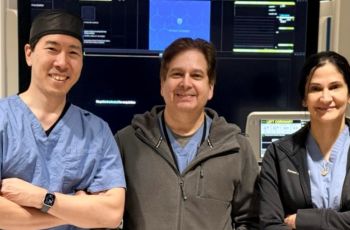
A new research study led by Pedro Gazzinelli Guimaraes, PhD, assistant professor of microbiology, immunology, and tropical medicine, titled “Unraveling the Hidden Regulator: Deciphering Endogenous Retroelement Control of Allergic Type 2 Immune Response,” seeks to understand how dormant viruses in our DNA become reactivated during allergy development and how this process may drive lung inflammation caused by house dust mites. The goal is to identify new ways to prevent or treat asthma and related diseases.
The study, which brings together collaborators from around the world, across the United States, and colleagues at the George Washington University (GW) School of Medicine and Health Sciences (SMHS), is funded through a five-year, non-renewable National Institutes of Health DP2 New Innovator Award, and marks the first time a GW researcher has received the grant. Administered through the National Institute of Allergy and Infectious Diseases, the award supports creative next-generation scientists looking to make big leaps forward in medical science that could transform how we understand or treat disease.
“This is a high-risk, high-reward grant for early career researchers exploring completely out-of-box ideas,” Gazzinelli explained. The program offers promising researchers the freedom and resources to pursue risky but potentially groundbreaking projects.
Conventional grant mechanisms, he added, require extensive preliminary data. “The goal of this grant is to allow early career researchers to generate the body of data they need to pursue a conventional grant and establish their careers.”
Asthma and other allergic lung diseases are becoming increasingly common, with asthma affecting more than 260 million people worldwide, according to the World Health Organization. Scientists already understand much about how the immune system reacts once an allergy is underway, such as the Type 2 immune response, which involves cells and molecules that drive allergy symptoms. What remains unclear is what initiates this process in the first place, at the surface of the lungs where allergens first come into contact with the body.
About 8% of human DNA originates from ancient viruses, called endogenous retroviruses (ERVs), that infected our ancestors millions of years ago. Normally, these viral sequences are inactive, but sometimes they can “wake up” and become active again. This reactivation has been linked to diseases such as cancer, autoimmune disease, and neurological disorders, but its role in allergies has not yet been explored.
In his study, Gazzinelli aims to determine whether ERVs help trigger or worsen allergic inflammation in the lungs caused by dust mite exposure. Researchers have already found early evidence that ERVs become more active in both humans and mice with allergies. Gazzinelli will explore how ERV reactivation affects allergic inflammation and examine how ERV activity is regulated at the epigenetic level.
“We’re studying allergic diseases, and we’re trying to understand the mechanisms of how people get allergic, how they develop asthma, and why some people develop lung inflammation when they are exposed to one allergen when others who are exposed to the same allergen don’t develop pathology,” he explained.
Gazzinelli and his collaborators’ hypothesis is that when allergens first sensitize the lungs they might cause these silenced viral genes to reactivate. That reactivation could intensify the allergic immune response. It could prompt the body to produce more mucus, activate allergy-related cells, and increase the antibodies involved in allergic reactions.
By connecting the dots between our body’s ancient viral DNA, the lung’s protective lining, and dust mite–triggered immune responses, Gazzinelli hopes to reveal new insights that eventually could lead to the prevention or treatment of asthma and other allergic diseases.
“We are doing basic research to understand the how, when, and why this allergic sensitization occurs and what are the implications of that,” he said. “We are using both experimental models and human clinical samples, so eventually we could make this very translational to apply any findings to the clinic to see if we can use this as an alternative therapy against allergic inflammation.”



